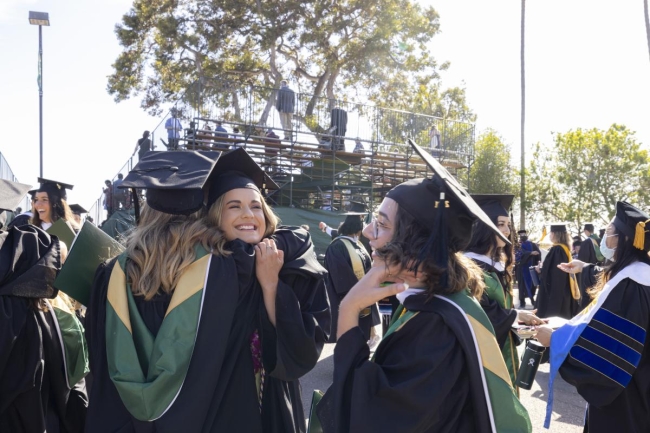You have /5 articles left.
Sign up for a free account or log in.

Marcus Emerson/Point Loma Nazarene University
What do undergraduates want from professors? I found students’ responses to this question from a survey conducted by Inside Higher Ed and College Pulse both compelling and familiar in that the top three answers all deal with employability expectations. When asked what kind of guidance they sought beyond the core task of teaching them course materials, by far the highest percentage (57 percent) of respondents to the Student Voice survey say they want professors to introduce them to people working in their fields of interest. That is followed closely by the desire for advice from professors on choosing a career direction (54 percent), and then 47 percent want help landing their first internship or job.
As provost of Point Loma Nazarene University (PLNU), where I am overseeing a radical reinvention of our career services activities, these findings simply underscore the pressing need to rethink how we serve students. I aspire to accommodate students’ desire for authentic, focused career advice in which faculty play a central role.
We already know from the CIRP College Freshmen survey from the Higher Education Research Group at the University of California, Los Angeles, that 85 percent of students nationwide say getting a job is a key factor in their decision to go to college. Two-thirds rank financial security as their top motivation for pursuing a degree. Of the needs students expect college to provide, half are career related. And not surprisingly, the Inside Higher Ed/College Pulse survey, conducted with support from Kaplan, provides renewed evidence that students expect their faculty to be actively involved in helping them reach these goals.
A combination of program review, staff turnover and other one-time factors gave my institution—a small, private, faith-based liberal arts university in Southern California—a unique opportunity to show how our tiny corner of the higher ed world could better address students’ expectations. We are making career readiness more central to what we do, both inside and outside the classroom.
If equity in student access to career services functions is one of our commitments, there couldn’t be a clearer way of conveying this to all concerned than by housing it in academics.
Our students, especially our first-generation students—and their parents—have been telling us for a while that they need their college education to lead to an unmistakable return on investment. That means we need the degrees we provide to develop career readiness skills and offer clear pathways to student employability. We are beginning to do just that, using a mixture of organizational restructuring, faculty development and distinct programmatic reforms.
Actions We Took
On the organization front, for practical and symbolic reasons, we created a structure in which the career services function moved out of student life and into academics, now reporting up to me as provost. If equity in student access to career services functions is one of our commitments, there couldn’t be a clearer way of conveying this to all concerned than by housing it in academics.
 This shift displays that career services isn’t an afterthought or part of a laundry list of optional add-on student experiences. Rather, by embedding it in academics, it becomes an essential part of what we do, having ramifications for the role of our faculty—and to mine as provost.
This shift displays that career services isn’t an afterthought or part of a laundry list of optional add-on student experiences. Rather, by embedding it in academics, it becomes an essential part of what we do, having ramifications for the role of our faculty—and to mine as provost.
This sounds nice on paper, but how do we turn this commitment into a reality?
First, we made an immediate personnel change by completely rethinking our career services staffing model. We moved away from the “career coach” approach in which a small number of specialists in a few career fields worked with students one-on-one. The personal attention was great, but an individual, transactional model is not scalable, especially with five different campus locations and a combination of face-to-face, online and hybrid teaching modalities. We needed a way to reach all our students and cater to their wide range of career interests.
So we hired a small team of multifaceted program managers, often not from traditional career services backgrounds. They could share their own distinctive career stories, such as one counselor’s stint managing an Enterprise car rental franchise, working in a CrossFit fitness studio and working in the nonprofit world while earning a graduate degree in sociology. These program managers make connections well beyond their own expertise, such as organizing group career discussions or working across academic departments to connect students to faculty in different fields, from whom they crave advice and career connections.
In addition, we are making focused efforts with our academic unit leaders to embed career readiness into every academic major on campus. The central component of this initiative is a “major map” developed by academic program leaders in partnership with career services staff. The resulting document/graphic shows which career-readiness skills are developed within a given major and what assortment of career pathways our alumni have taken.
[block:block=176]
These major maps are vital for students, but they’re also extremely popular with parents during the admissions and enrollment process.
For example, simply knowing that PLNU has developed recruiting partnerships in which firms in San Diego’s thriving biotech scene will give hiring consideration to our science graduates goes a long way toward reassuring parents that we see our responsibility as extending from core academics to starting careers. Pathways for our science graduates into biotech companies are just the first step, as all these companies also have needs for graduates with training in fields like accounting, marketing, PR, HR, writing and communication. So partnerships within a particular industry sector don’t just create pathways for graduates with majors that directly aligned to the sector’s main thrust (e.g., biotech), but they also create pathways for graduates who studied in a wide variety of other disciplines that may not, at first, seem directly related.
Another component of our career services reinvention involves our investment as a designing partner with Kaplan’s Career Core services. Pioneered at Wake Forest University, this developing model has two components:
Read more from the survey on student views of faculty, including ideas for how students and professors can develop stronger connections, at the Student Voice news hub.
- A series of asynchronous online learning journeys provides students exposure to a wide range of career possibilities.
- Undergraduates drill down on specific interests, participating in synchronous online group coaching sessions with industry-specific leaders.
Our hope is that with our small staff and a modest budget, this partnership will allow us to offer career services of a scope and scale that just wouldn’t be possible otherwise. While we are still early in our transition, I am optimistic that Career Core’s innovative shared services model will be a game changer for not only PLNU, but for other institutions as well.
I certainly wouldn’t claim that changes this extensive have been easy. In the diverse context of the academy, there is inevitably some pushback from those who need further persuasion that career readiness doesn’t detract from our academic mission—and is a valuable component of PLNU’s success. But I’m convinced that this kind of creative rethinking—together with a force multiplier provided by something like our partnership—serves students much more effectively than what it replaces. It also can position our small institution for further success in a highly competitive, and not always predictable, admissions and enrollment landscape.








